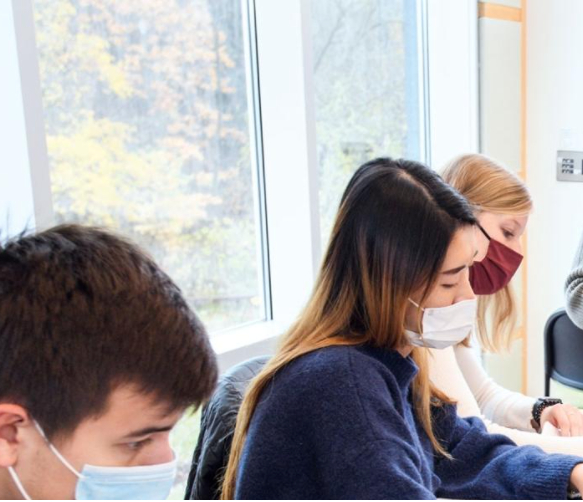
Masks are still required in classes, unless the instructor specifies that masks are not necessary. Photo courtesy of Hamilton College.
Effective Thursday, March 3, the College has further relaxed campus mask requirements. “Masks are still required in classes, labs or studios while class is in session, unless the instructor specifies that masks are not necessary,” stated an email from the COVID-19 Task Force on Tuesday, March 1. According to Karen Leach, Chair of the Task Force, professors can freely lift the mask requirement in their classes, but should explicitly announce that decision in advance.
Unmasking is now the default for all spaces except those outlined in the all-campus email, namely when inside the Testing Center, Health Center, Athletics Training Center and at large gatherings if requested by the organizers. Other small changes are easy to miss. Previously, masks were required at indoor events with external audiences, and vaccinated visitors to Hamilton were required to wear masks when in any public area.
Professors’ office hours are not subject to classroom mask requirements. Though not required, any faculty or staff can require visitors to wear a mask in their individual office (but not public spaces). Signs printed with this request can be picked up at the Testing Center.
Likewise, “a student who would like a faculty or staff member to mask when they are in close quarters, such as an office, may ask the other person to do so,” says Leach. “I notice too that people are also practicing a new etiquette, asking ‘Would you like me to wear a mask?’ And I can easily say yes or no. That makes it easier for everyone. In general, if the person you are meeting with is wearing a mask, it’s a good idea to assume they would like you to wear one too.”
Allowing individual faculty members to decide whether to enforce mask-wearing in classes has garnered a variety of approaches. According to the new CDC COVID-19 Community Level classifications released on Saturday, Feb. 26, Oneida County is now categorized as Low Community Transmission, and masks are no longer strongly recommended for vaccinated individuals. People who are symptomatic, have tested positive or have been exposed to someone with COVID-19 should always wear a mask.
However, the seven-day case rate per 100k is still 123 people. This was considered “High Community Transmission” as of four days ago, and still shows up as Red on some areas of the CDC website. These sudden sweeping changes may keep some professors wary of relaxing mask requirements, while others welcome the changes.
Professor Mark Cryer, Chair of the Theatre Department, is thrilled about the change. In class, he has been outspoken about the importance of teaching theatre without masks as soon as it became safe to do so. He stated, “Actors use a variety of tools to communicate, and our faces and facial expressions are part of those tools. A smile, a frown, a slightly upturned lip can speak a paragraph of dialogue and we miss that in masks. Moreover, speaking is made more difficult and articulation and vocal projection require more effort for the actor to be understood clearly.”
Others, like Professor Jennifer Borton of the Psychology Department, are choosing to be more cautious. For larger classes like Psychology Statistics and Research Methods, with 40 people packed tightly in a classroom, she believes that the benefits of staying masked outweigh the drawbacks for the time being. There is only a week and a half until spring break begins, where students will travel all over the country and likely be exposed to COVID, so she will re-evaluate her decision a few weeks after break when “rates will ideally be very low again.”
Ultimately, Professor Borton hopes to go mask-free, but she wants “to be respectful of students and those who are vulnerable, or have underlying conditions.” In the Psychology Department, two professors have a young baby, while many others have children in K-12 schools that have gone maskless. The department is nervous about the possibilities of both bringing COVID into Hamilton and catching it from students. Professor Borton does miss seeing students’ faces, and before this semester’s stricter mask requirements would in fact teach in a clear mask so students could always see her smile. “Do I hate my mask? Yes,” she laughed, “but in light of people with underlying conditions or unvaccinated babies, I’d rather be safe than sorry.”
Professor Peter Cannavò, Chair of the Government Department, is gathering opinions from each of his students before making a decision. “This isn’t going to be by majority rule,” he said, and the mask requirement will stay in place “if anyone is uncomfortable with going unmasked, even if that’s just one student.”
Professor Cannavò refused to voice his own personal opinion in class, because “there is a lot of pressure to conform, one way or another, especially with masks,” and he does not want to add to it. Instead of starting a public discussion, Professor Cannavò asked students to email him privately or even anonymously with any concerns, then connected the subject back to the Intro to Political Theory class’ timely discussion on conformity.
While the College has relaxed mask requirements, professors are still cautiously weighing factors such as student opinions and personal risks of COVID transmission.